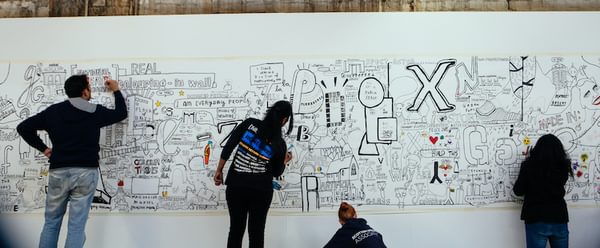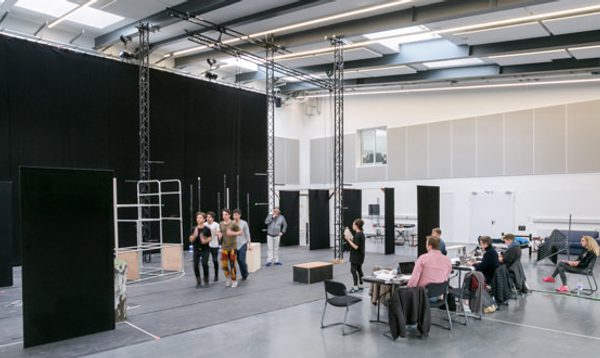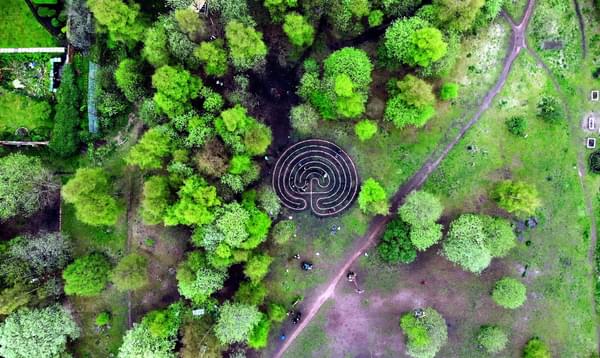Our Process
For Artists
As Scotland’s National Theatre company, it is our unique responsibility to make work by the broadest range of artists for the biggest and broadest audiences across Scotland (and where successful at home, abroad).
We are an artist and ideas led, audience focused company.
Practically, this means that it is ‘ideas’, conceived by artists, that will resonate with the biggest and most diverse audiences, that we consider first for commission/development and then ultimately a place in our programme.
We usually have around 40 projects in development in any year, lined up for programmes up to 3 years ahead. These are selected through conversations with artists we are proactively building relationships with. As a result, we are very unlikely to be able to offer financial support or programme opportunities for unsolicited ideas.
We therefore offer a range of opportunities for you to build a relationship with us, and access in-kind and paid support through a series of open calls. Click here for more information.
About National Theatre of Scotland Productions
Our artistic programme is guided by our Strategic Framework.. This is updated every 5 years, and in response to the cultural climate, reflections on the content and success of previous programmes of work and which theatre forms, communities and artists we have not yet collaborated with.
Each annual programme of productions and opportunities looks slightly different, as we can’t achieve our full range of strategic ambitions in any one year. For examples of our previous work – click here. However there are a range of platforms and models we regularly use to present work, and these platforms often intersect:

- Nationwide Touring - a work which may be small scale in production so can fit in the back of a van and be able to tour to rural community spaces (e.g. town and village halls, school gyms)
- Midscale Touring - a work which will likely tour to venues with seating for around 600-800 people (such as Dundee Rep, Tron Theatre, Eden Court, Beacon Arts Centre)
- Sited/ Landscape - a work which will be rooted in a particular non-theatre place or landscape
- Digital/ Screen - a work that can be presented to either online audiences, screen audiences, or be a hybrid of live and digital
- Participation - work made with and by a 'community' be that a geographic or cultural community
- Large Scale Touring (e.g. King's Theatre Glasgow, His Majesty's Theatre Aberdeen) - this is a work which is a large-scale production, with potential to be commercial, often with high profile cast and creative team and/or a known title or story.
- Edinburgh Festivals - a new work, or new adaptation that premieres as part of the Edinburgh Festival Fringe or International Festival in August
As we also have a responsibility to provide as many jobs for Scotland’s artists as possible, we will try to hire from here first and will look elsewhere when there are specific skillsets or specialities that need to be met by hiring from outwith Scotland and/or there is a potential benefit to Scottish artists in working with collaborators from a wider geographical area. We are unlikely to produce or support work that doesn’t have a tangible connection to Scotland and the hiring of Scotland’s artists.
We will usually not commit to producing a show until a commission/project is approaching readiness for production (i.e. it is realising its artistic and audience potential and we know enough about it to develop a tour, budgets, partnerships etc). Whether and when a show is programmed is also dependent on the other projects also ready to meet an audience, and how collectively we can curate a series of productions in any one year that will achieve audience diversity and reach, geographic reach, large employability opportunities, a diversity of stories and reflect a diversity of lived experiences across the cohort of lead artists.
How we develop work and make producing decisions
Once a project has been greenlit for support, at each stage of development, the Artistic Development team will set clear parameters and outcomes with artists. This will include what is needed to make decisions for the next phase.
We start by asking an artist what questions they want to answer, and tailor a development/commission plan around how best to find the answers to that, which might include (but is not limited too):
- Solo research time/trip
- Time in room with collaborators
- Writing a treatment for a play
How the artist can best share the answers to their questions might be through: a sharing of practical work generated, first draft of a play, a conversation.
Once each development phase is complete, the company and artist will decide on the next step on the development journey, repeating this process.
Every project in development will take a different length of time to be ready for programme consideration, often taking a number of years, so we only add a small number of new projects to the list of projects in development (the development slate) in any one year.

